Abstract
Panel unit root tests of real exchange rates—as opposed to univariate tests—usually reject non-stationarity. These tests, however, could be biased if the real exchange rate contained MA roots. Indeed, two independent arguments claim that the real exchange rate, being a sum of a stationary and a non-stationary component, is possibly an ARIMA (1, 1, 1) process. Monte Carlo simulations show how systematic changes in the parameters of the components, of the test equation and of the correlation matrix affect the size of first and second-generation panel unit root tests. Two components of the real exchange rate—the real exchange rate of a single good and a weighted sum of relative prices—are constructed from the data for a panel of countries. Computation of the relevant parameters reveals that panel unit root tests of the real exchange rate are severely oversized, usually much more so than simple augmented Dickey-Fuller tests. Thus, the evidence for purchasing power parity from first and second-generation panel unit root tests may be merely due to extreme size biases.
Similar content being viewed by others
References
Balassa B (1964) The purchasing-power parity doctrine: a reappraisal. J Political Econ 72: 584–596
Blough SR (1992) The relationship between power and level for generic unit root tests in finite samples. J Appl Econ 7: 295–308
Breitung J, Das S (2005) Panel unit root tests under cross sectional dependence. Stat Neerl 59: 414–433
Breitung J, Pesaran MH (2008) Unit roots and cointegration in panels. In: Mátyás L, Sevestre P (eds) The econometrics of panel data—fundamentals and recent developments in theory and practice, 3rd edn. Springer, Berlin, pp 279–322
Campbell JY, Perron P (1991) Pitfalls and opportunities: what macroeconomists should know about unit roots. NBER Macroecon Annu 1991: 141–201
Clark PK (1988) Nearly redundant parameters and measures of persistence in economic time series. J Econ Dyn Control 12: 447–461
Coakley J, Fuertes A-M (2000) Is there a base currency effect in long-run PPP? Int J Financ Econ 5: 253–263
Cochrane JH (1991) A critique of the application of unit root tests. J Econ Dyn Control 15: 275–284
Devereux MB (1997) Real exchange rates and macroeconomics: evidence and theory. Can J Econ 30: 773–808
Dornbusch R (1987) Purchasing power parity. In: Eatwell J, Milgate M, Newman P (eds) The new palgrave: a dictionary of economics. Macmillan Press, London, pp 1075–1085
Driver RL, Westaway PF (2005) Concepts of equilibrium exchange rates. In: Driver R, Sinclair P, Thoenissen C (eds) Exchange rates, capital flows and policy. Routledge, London, pp 98–148
Engel C (2000) Long-run PPP may not hold after all. J Int Econ 57: 243–273
Fischer C (2006) PPP: a disaggregated view. Appl Financ Econ 16: 93–108
Froot KA, Rogoff K (1995) Perspectives on PPP and long-run real exchange rates. In: Grossman GM, Rogoff K (eds) Handbook of international economics, Vol 3. Elsevier, Amsterdam, pp 1647–1688
Fuller W (1976) Introduction to statistical time series. John Wiley, New York
Hamilton JD (1994) Time series analysis. Princeton University Press, Princeton
Harvey A, Bates D (2002) Multivariate unit root tests and testing for convergence. DAE Working Paper No 0301
Higgins M, Zakrajšek E (1999) Purchasing power parity: three stakes through the heart of the unit root null. Federal Reserve Bank of New York Staff Reports No 80
Hlouskova J, Wagner M (2006) The performance of panel unit root and stationarity tests: results from a large scale simulation study. Econ Rev 25: 85–116
Hsieh DA (1982) The determination of the real exchange rate: the productivity approach. J Int Econ 12: 355–362
Im KS, Pesaran MH, Shin Y (2003) Testing for unit roots in heterogeneous panels. J Econ 115: 53–74
Jönsson K (2005) Cross-sectional dependency and size distortion in a small-sample homogeneous panel data unit root test. Oxf Bull Econ Stat 67: 369–392
Levin A, Lin C-F, Chu C-SJ (2002) Unit root tests in panel data: asymptotic and finite-sample properties. J Econ 108: 1–24
Ng S, Perron P (2002) PPP may not hold after all: a further investigation. Ann Econ Financ 3: 43–64
O’Connell PGJ (1998) The overvaluation of purchasing power parity. J Int Econ 44: 1–19
Papell DH (2006) The panel purchasing power parity puzzle. J Money Credit Bank 38: 447–467
Papell DH, Theodorides H (2001) The choice of numeraire currency in panel tests of purchasing power parity. J Money Credit Bank 33: 790–803
Rogoff K (1996) The purchasing power parity puzzle. J Econ Lit 34: 647–668
Samuelson PA (1964) Theoretical notes on trade problems. Rev Econ Stat 46: 145–154
Sarno L, Taylor MP (2002) The economics of exchange rates. Cambridge University Press, Cambridge
Schwert GW (1989) Tests for unit roots: a Monte Carlo investigation. J Bus Econ Stat 7: 147–159
Taylor AM, Taylor MP (2004) The purchasing power parity debate. J Econ Perspect 18: 135–158
Wu J-L, Wu S (2001) Is purchasing power parity overvalued? J Money Credit Bank 33: 804–812
Author information
Authors and Affiliations
Corresponding author
Rights and permissions
About this article
Cite this article
Fischer, C., Porath, D. A reappraisal of the evidence on PPP: a systematic investigation into MA roots in panel unit root tests and their implications. Empir Econ 39, 767–792 (2010). https://doi.org/10.1007/s00181-009-0321-7
Received:
Accepted:
Published:
Issue Date:
DOI: https://doi.org/10.1007/s00181-009-0321-7




